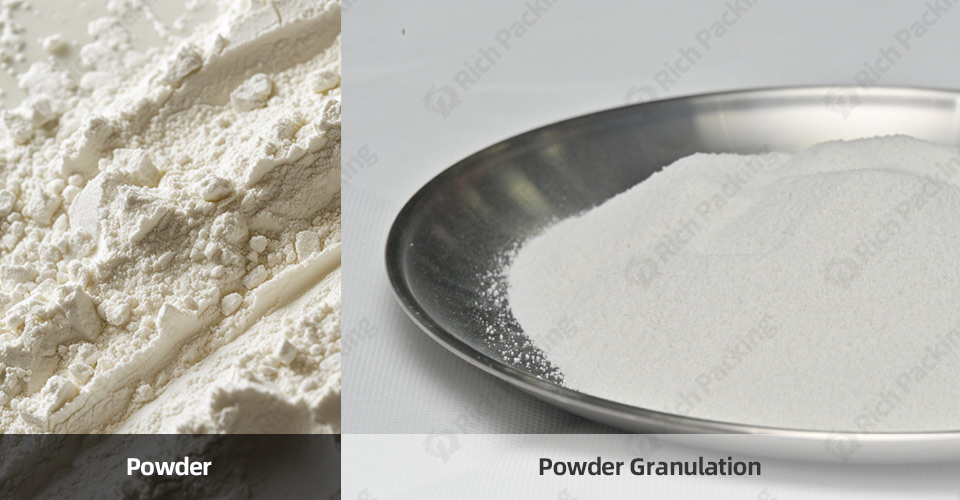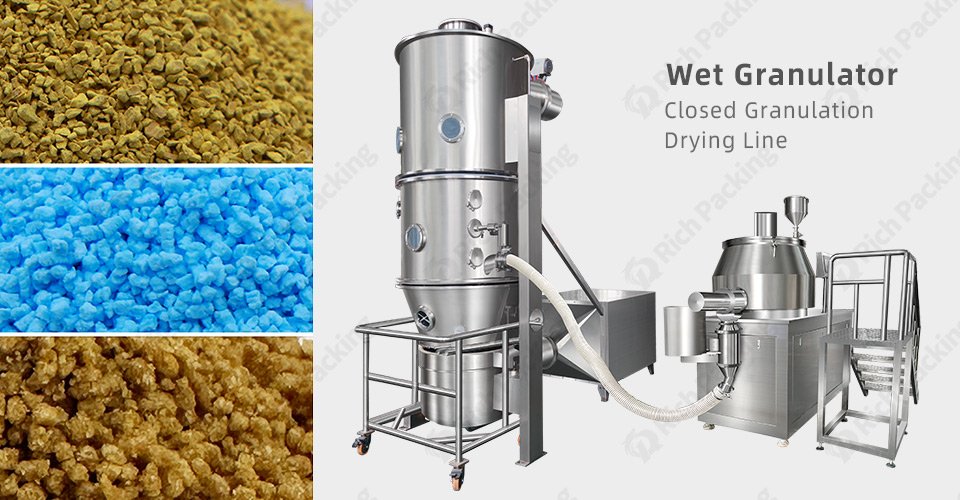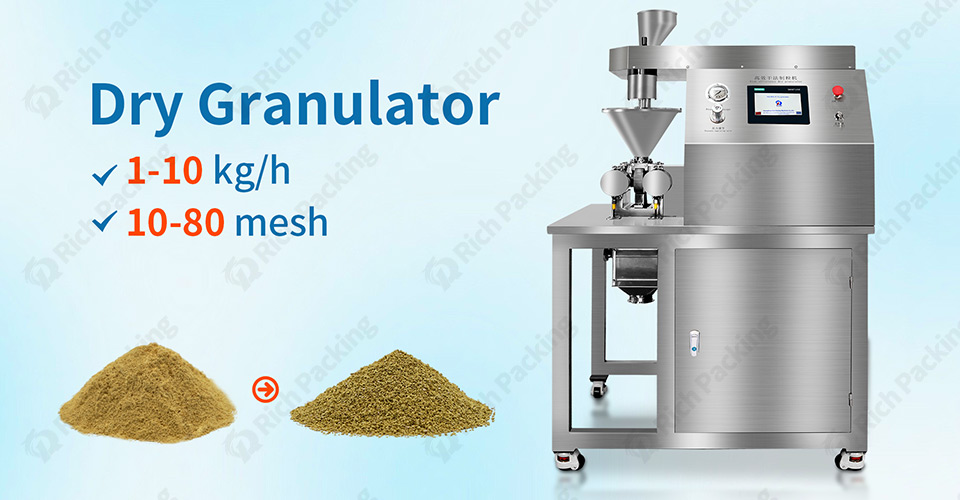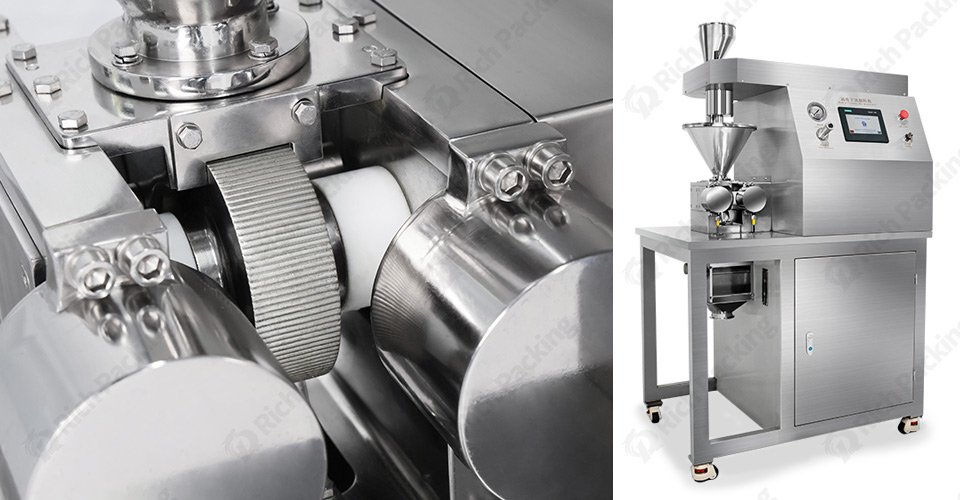في تصنيع الأقراص، تعد عملية طحن المواد الخام وتحبيبها قبل التحبيب خطوات أساسية في تحديد جودة الأقراص واتساقها. إن إتقان استخدام هذه العمليات ومعداتها لا يمكن أن يحسن كفاءة الضغط على الجهاز اللوحي الإنتاج، ولكن أيضا ضمان استقرار وسلامة المنتج النهائي. سوف تشرح هذه المقالة بالتفصيل الجوانب المهمة لعمليات الطحن والحبيبات وتقدم توصيات للمعدات ذات الصلة.

يُعدّ التفتيت والتحبيب خطوتين أساسيتين في عملية تصنيع الأقراص، إذ يُحددان جودة القرص النهائي وكفاءة عملية التحبيب. في صناعة الأدوية، تحتاج إلى معالجة جزيئات أو كتل كبيرة من المواد وتحويلها إلى حبيبات مناسبة للتحبيب. يُحسّن الحجم والشكل المناسبان للحبيبات تدفق الأقراص وقابليتها للانضغاط بشكل فعال، ويضمن عملية تحبيب سلسة، ويمنح الأقراص النهائية وزنًا وصلابة ووقت تفكك ثابتًا. على سبيل المثال، قد تُؤدي الحبيبات الكبيرة جدًا إلى تفاوت صلابة الأقراص أثناء عملية الضغط، بينما قد تؤثر الحبيبات الصغيرة جدًا على ذوبان الأقراص. لذلك، فإن تحسين خطوات الطحن والتحبيب لا يُسهم فقط في تحسين الإنتاجية، بل يضمن أيضًا جودة المنتج الثابتة.
السحق هو عملية معالجة المواد الخام الكبيرة وتحويلها إلى جزيئات دقيقة أو مساحيق تمهيدًا لعمليات التحبيب والتقطيع اللاحقة. عند اختيار معدات السحق، يجب مراعاة صلابة المادة الخام ونسبة رطوبتها وخصائصها الفيزيائية لضمان تجانس الحبيبات النهائية وتدفقها. فيما يلي بعض الأنواع الشائعة من معدات السحق وتطبيقاتها.
تصنيف وسيناريوهات تطبيق معدات الطحن:
|
نوع الجهاز |
سيناريو التطبيق |
ميزة |
عيب |
|
طاحونة الهواء |
المواد الحساسة لدرجة الحرارة والتي تتطلب معالجة بدرجة حرارة منخفضة |
سرعة عالية، لا تلوث |
تأثير ضعيف على المواد الصلبة |
|
مطحنة عالية الكفاءة |
مواد خام عالية الحجم وذات صلابة عالية |
سريع وفعال وقابل للتكيف |
التعامل المحدود مع المواد الحساسة للحرارة |
|
مطحنة المطرقة |
مناسب للمواد متوسطة الصلابة والهشة مثل الأعشاب والمواد النباتية الجافة |
سهلة التشغيل، منخفضة التكلفة |
غير مناسب للطحن الدقيق للغاية ومستوى الضوضاء العالي |
|
مطحنة الكرات |
مناسب للطحن الدقيق للغاية، مثل تكسير الخلايا والمواد النانوية |
دقة عالية للغاية |
استهلاك عالي للطاقة ووقت سحق طويل |
مطحنة المطرقة: هي معدة سحق شائعة الاستخدام لسحق المواد متوسطة الصلابة والهشة، مثل الأعشاب والخامات والمواد النباتية الجافة. تُطحن المواد بمطارق دوارة عالية السرعة للسحق الأولي، وتتحكم في حجم المواد المسحوقة من خلال غربال. من أهم مزايا مطحنة المطرقة بساطة هيكلها، وانخفاض تكلفتها، وقدرتها على التكيف، وهي تُستخدم على نطاق واسع في مصانع ومختبرات الأدوية الصغيرة والمتوسطة الحجم. مع ذلك، يجب الانتباه إلى أن مطحنة المطرقة قد يكون أداؤها ضعيفًا عند التعامل مع مساحيق أو مواد دقيقة للغاية تتطلب تحكمًا دقيقًا. كما أنها تُصدر ضوضاء أثناء التشغيل، وتتطلب تحكمًا جيدًا في الضوضاء في بيئة التشغيل.

تُستخدم عملية التحبيب الرطب لتشكيل الحبيبات عن طريق خلط المساحيق والمواد الرابطة السائلة لتحسين تدفق الحبيبات وقابليتها للضغط ولضمان استقرار عملية التحبيب اللاحقة. تُستخدم هذه العملية على نطاق واسع في صناعة الأدوية وهي مناسبة بشكل خاص للمنتجات التي تتطلب درجة عالية من ثبات الحبيبات وتجانسها.
تصنيف وتطبيق معدات التحبيب الرطب:
|
نوع الجهاز |
سيناريو التطبيق |
ميزة |
|
حبيبات السرير المميع |
مناسب لمعالجة المواد الخام الحساسة للحرارة |
توحيد الجسيمات توحيد الجسيمات العالي، مناسب للإنتاج الضخم |
|
حبيبات الخلط |
مناسب للحبيبات السريعة والإنتاج الضخم |
سهل التشغيل، مناسب للإنتاج بكميات صغيرة |
|
حبيبات دوارة |
مناسب للمواد اللزجة القوية والجسيمات الموحدة |
تأثير التحبيب للمواد اللزجة جيد، والتحكم في حجم الجسيمات أكثر دقة |
تُشكّل آلة التحبيب المميعة الحبيبات عن طريق تعليق المسحوق في تيار هوائي مع رشّ مادة رابطة سائلة. وهي مناسبة للتعامل مع المواد الحساسة للحرارة، وتضمن تجانس الحبيبات وتماسكها، وتُستخدم عادةً في الصناعات الدوائية والغذائية وغيرها من الصناعات التي تتطلب حبيبات عالية الجودة.
مميزات جهاز التحبيب بالتحريك الرطب:
يعتمد مبدأ عمل مُحبب التحريك على خلط المسحوق والسائل بتحريك ميكانيكي، للحصول على حبيبات متجانسة. يتميز مُحبب التحريك بسهولة التشغيل، وهو مناسب بشكل خاص للإنتاج بكميات صغيرة ومتوسطة. يمكن ضبط سرعة الخلط وكمية المادة الرابطة وفقًا لخصائص المواد المختلفة، مما يضمن تحكمًا أكثر دقة في الحبيبات. بالمقارنة مع مُحبب الطبقة المميعة، فإن مُحبب التحريك أقل تكلفةً ومناسبًا لبيئات الإنتاج ذات الميزانيات المحدودة.

يُشكّل التحبيب الجاف جزيئاتٍ عن طريق ضغط المسحوق مباشرةً دون إضافة مادة رابطة سائلة. وهو مناسبٌ بشكلٍ خاص للمواد غير المناسبة للتلامس مع السوائل، مثل بعض المكونات النشطة سريعة الذوبان أو الحساسة للحرارة أو غير المستقرة. مقارنةً بالتحبيب الرطب، يُغني التحبيب الجاف عن خطوة التجفيف، ويُقلل بشكلٍ كبير من استهلاك الطاقة والوقت.

مُحبب جاف مضغوط بالأسطوانة: يُضغط المسحوق إلى رقائق بفعل الضغط بين أسطوانتي ضغط، ثم تُسحق وتُغربل لتكوين حبيبات. ميزته هي عدم الحاجة إلى مادة رابطة سائلة، مما يجعله مناسبًا بشكل خاص للمواد الخام غير المناسبة للمعالجة الرطبة. بالإضافة إلى ذلك، يُقلل التحبيب الجاف من استهلاك الطاقة بشكل كبير، إذ يُغني عن خطوة التجفيف اللاحقة.
أثناء التحبيب الجاف، يجب التأكد من أن المادة الخام قابلة للضغط بشكل كافٍ، وإلا فقد ينتج عن ذلك تكوين كريات رديء أو كثافة غير متساوية. تُناسب هذه الطريقة عادةً التعامل مع المكونات الصيدلانية الفعالة الحساسة للرطوبة أو عند الحاجة إلى إنتاج سريع.

يُعدّ حجم الجسيمات وتجانسها عاملين أساسيين لجودة الأقراص المراد ضغطها. فالجسيمات الكبيرة أو الصغيرة جدًا تؤثر على تدفق الأقراص المضغوطة وقابليتها للانضغاط، مما يؤثر بدوره على صلابة المنتج النهائي وذوبانه، بالإضافة إلى إطلاق تأثير الدواء. ويُعد التحكم في حجم الجسيمات في عملية التكسير والتحبيب جزءًا مهمًا لضمان اتساق الأقراص.
يمكنك اختيار معدات سحق وعمليات تحبيب مختلفة لتناسب مختلف المنتجات الدوائية واحتياجات الإنتاج. على سبيل المثال، يضمن السحق الدقيق تجانس الجسيمات بشكل أفضل، بينما يُحسّن التحبيب الرطب ضغط الجسيمات. بغض النظر عن المعدات المستخدمة، من الضروري التأكد من أن الحبيبات بالحجم المناسب وتلبي معايير الإنتاج.
يعتمد اختيار المعدات على حجم الإنتاج وخصائص المواد الخام ومتطلبات الإنتاج. إذا كنت تتعامل مع مواد حساسة للحرارة أو تحتاج إلى تحكم عالي الدقة، فقد تكون مطاحن تدفق الهواء ومحببات الطبقة المميعة خيارًا أفضل. أما لمعالجة كميات كبيرة من المواد متوسطة الصلابة، فتُعد مطاحن المطرقة ومحببات التحريك حلولًا أكثر فعالية من حيث التكلفة.
كما أن امتثال المعدات لمعايير GMP، ودرجة الأتمتة، وتكلفة الصيانة، عوامل أساسية يجب مراعاتها. عند اختيار المعدات، من الضروري التأكد من أنها تلبي احتياجات الإنتاج والمتطلبات التنظيمية.
يُعدّ الطحن والتحبيب خطوتين أساسيتين في إنتاج الأقراص، لا يُمكن تجاهلهما. باختيار المعدات والعملية المناسبة، يُمكنك زيادة الإنتاجية وضمان اتساق منتجاتك وأعلى معايير الجودة. سيساعدك فهم هذه العمليات وإتقانها على تحقيق نجاح أكبر في تصنيع الأقراص.